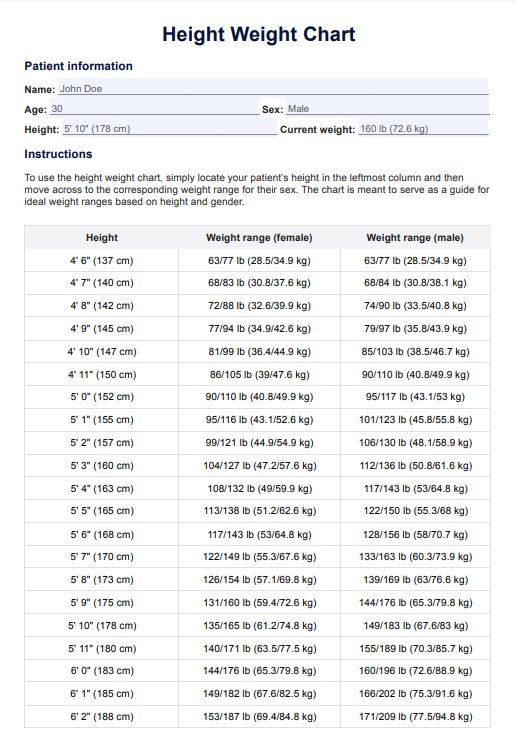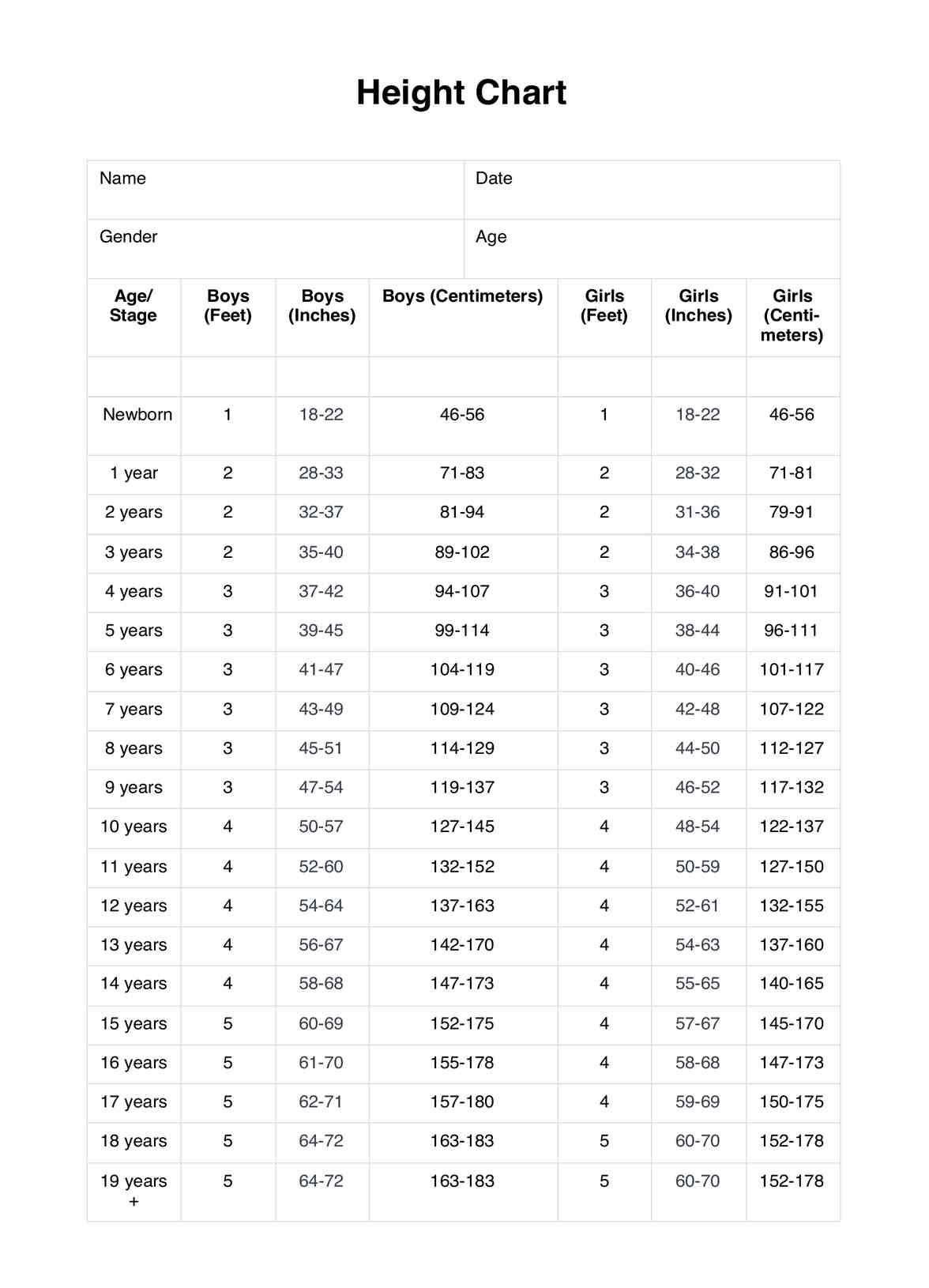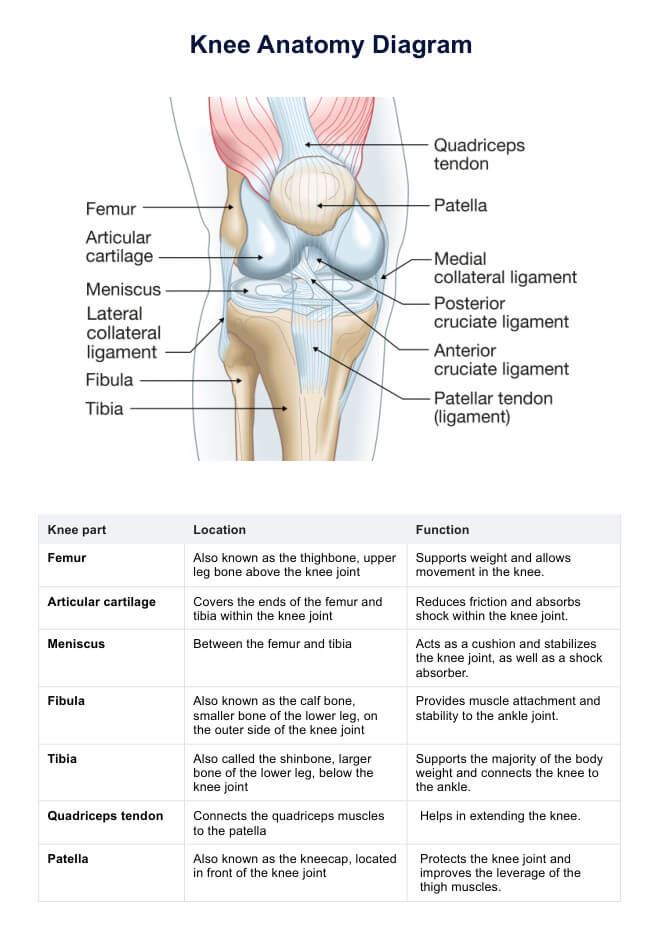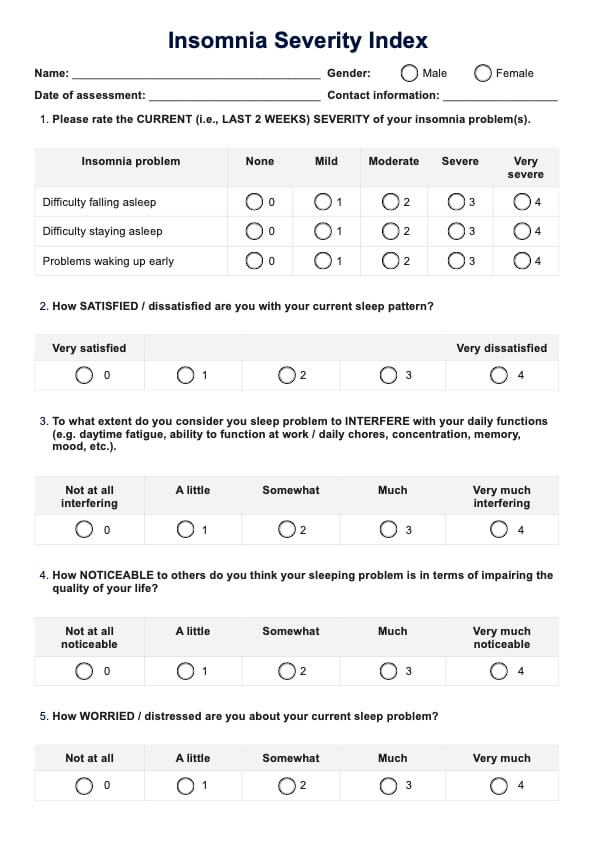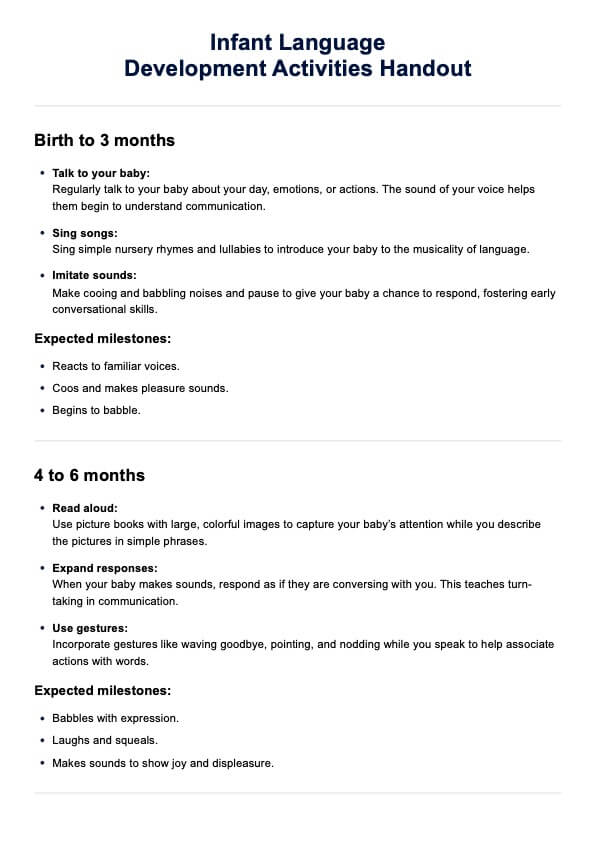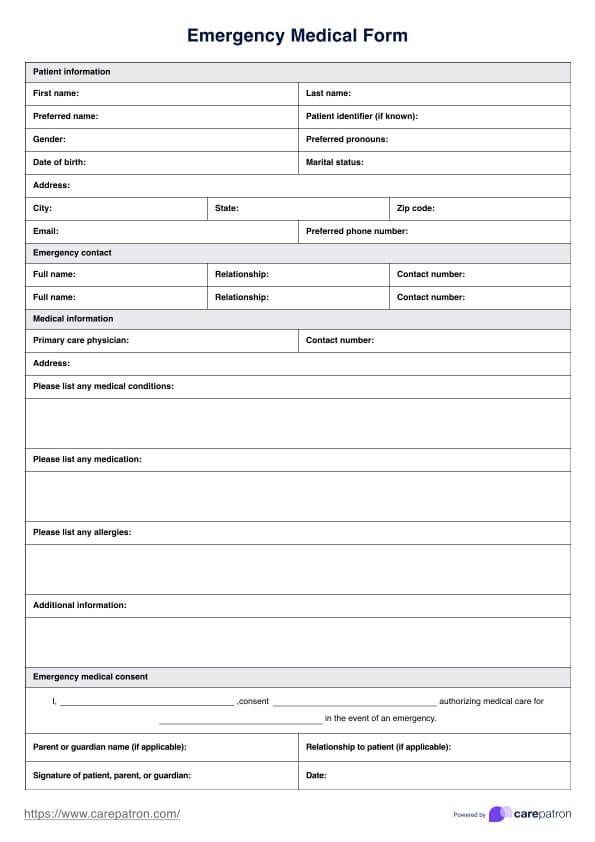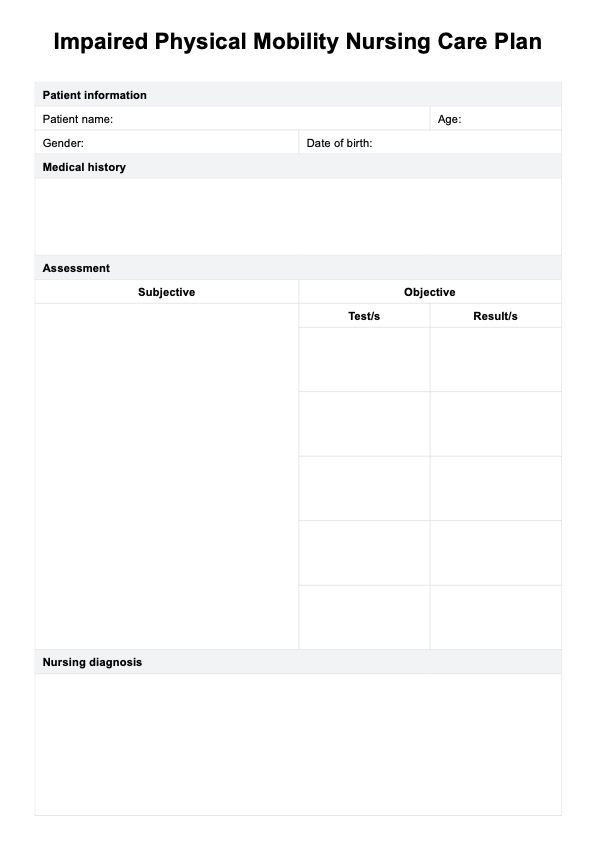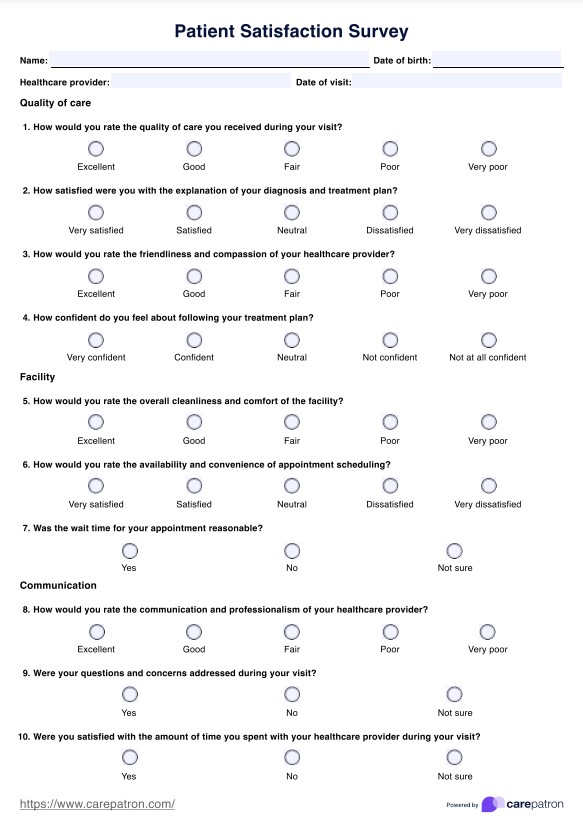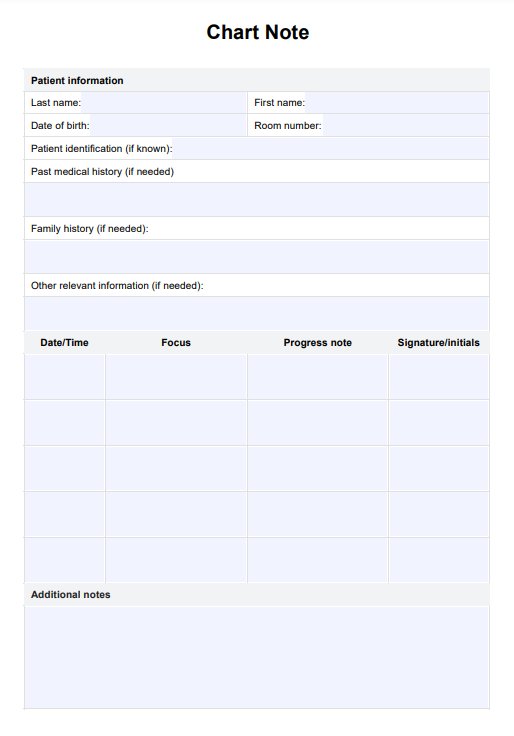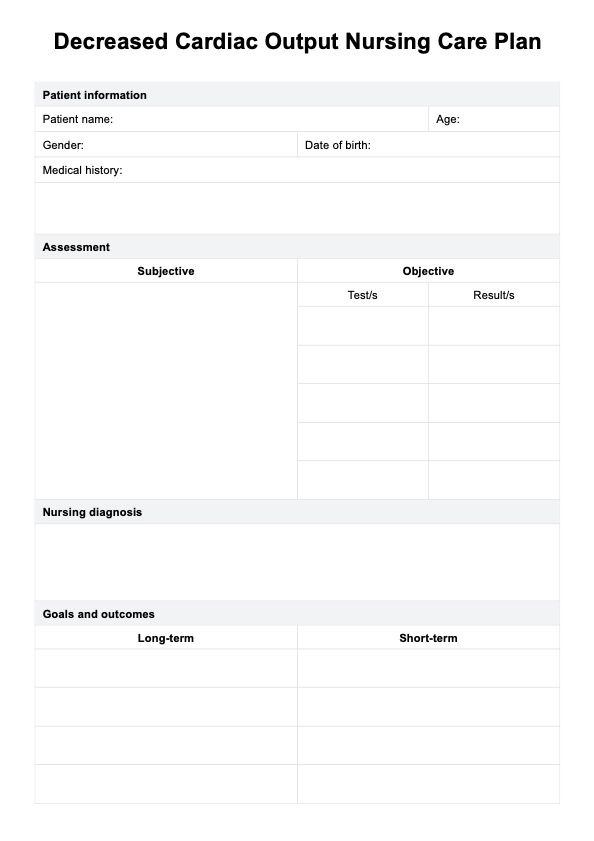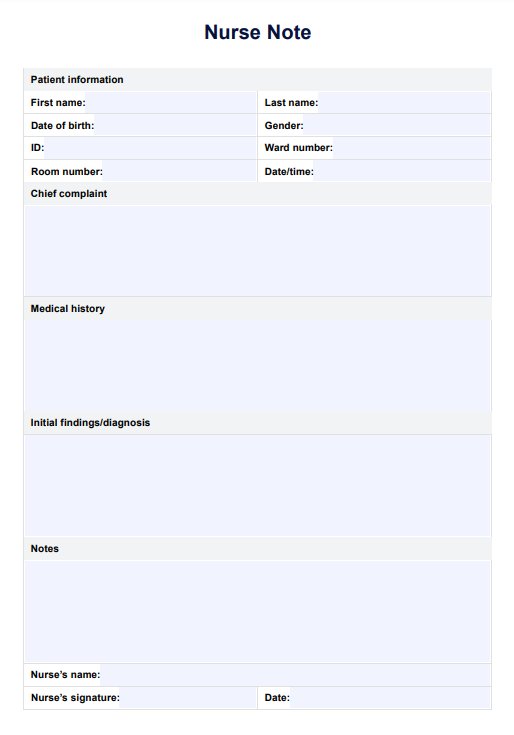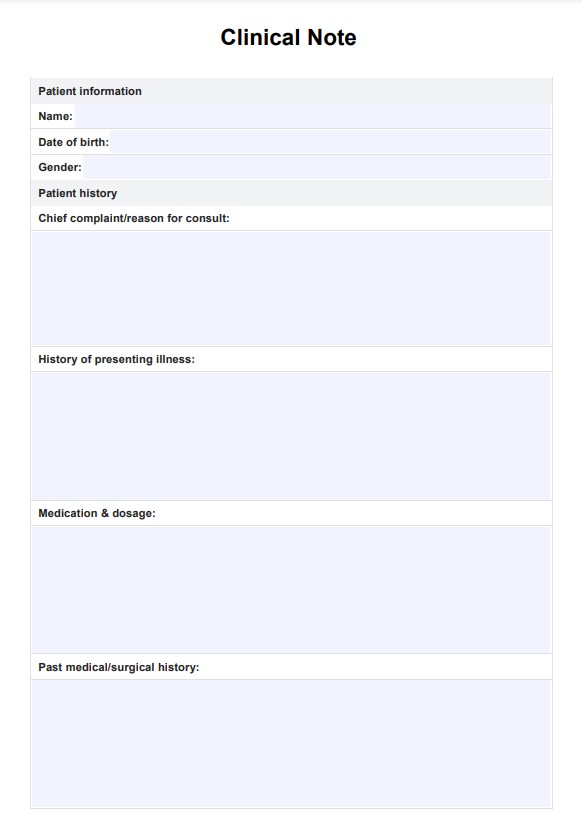Height Weight Charts
Learn about Height-Weight Charts and their use in healthcare practice. Find out your client's ideal body weight range and improve their health.


What is a Height Weight Chart?
A Height-Weight Chart provides an estimated healthy range for people of different heights, which can be helpful for healthcare professionals when assessing their patient's overall health status and determining if they are at increased risk of developing health conditions such as heart disease, diabetes and cancer.
The Height Weight Chart can also monitor an individual's journey to losing weight, shedding excess body fat, and attaining a healthier weight. For a healthy lifestyle, individuals should have a balanced diet by consuming ample fruits and vegetables while reducing fat, sugar, and salt intake and exercising regularly.
Remember that the chart is a general guideline and should not be used alone to assessing weight status and associated health risks. Healthcare professionals should combine it with other measures and provide personalized recommendations based on each patient's needs and lifestyle habits.
Consult our chart below to check whether your patients are the right height and weight for your age.
Height Weight Charts Template
Height Weight Charts Example
How does this visual Height and Weight Chart work?
Using a Height and Weight Chart provides a general guideline for ideal body weight ranges based on height, gender, and body size. However, it is essential to note that the ideal weight ranges offered are not a substitute for individualized medical advice regarding excess weight.
Step 1: Introduce the Height Weight Chart
Begin by introducing the chart to your patient and explaining the importance of maintaining a healthy weight range based on height and gender.
Step 2: Collect patient information
Gather the patient's name, age, sex, height, and weight. This information is essential to determine their body mass index (BMI) and the appropriate weight range for their height and sex.
Step 3: Locate height and weight on the chart
Locate the patient's height on the leftmost column of the chart, then move across to the corresponding ideal weight range for their gender. The chart is meant to serve as a guide for an ideal weight ranges based on height and sex.
Step 4: Interpret results
Once the patient's weight range is identified on the chart, compare it to their current weight to determine if they fall within the normal weight range. If they fall outside the recommended scope, create a plan for weight management and healthy living.
When should you use these Height Weight Chart templates?
Knowing the appropriate situations to utilize Height Weight Chart templates can enhance the effectiveness of your health and wellness assessments. Here are some instances when using these templates can be beneficial:
- Health assessments: Height Weight Chart templates are useful during routine health check-ups, enabling healthcare professionals to evaluate patients' weight quickly.
- Fitness goal setting: When embarking on a fitness journey, these charts can help individuals determine a healthy target weight based on height, aiding in goal setting and progress tracking.
- Children's growth monitoring: Parents and pediatricians can use these templates to track children's growth and ensure they develop within a healthy weight range.
- Medical research and studies: Researchers can use these templates to analyze trends and correlations between height, weight, and health outcomes.
- Public health initiatives: Government and non-government organizations can use these charts to create public health campaigns, raise awareness, and develop targeted interventions to combat obesity and promote healthy living.
Understanding when to use Height Weight Chart templates can help you better assess and monitor weight status, leading to more informed decisions, lifestyle changes and improved health outcomes.
Who is this Height Weight Chart PDF For?
Height Weight Chart is best for various professionals and individuals. The following practitioners may find this resource particularly useful:
- General practitioners and family doctors: This group can integrate the chart into routine check-ups to evaluate patients' weight status and offer tailored advice.
- Pediatricians: Using a Height-Weight Chart, pediatricians can monitor children's growth and development and ensure they stay within a healthy weight range.
- Dietitians and nutritionists: These professionals can use the chart to develop personalized meal plans and provide specific client recommendations based on weight status.
- Fitness trainers and coaches: Fitness trainers can use the Height Weight Chart to set clients' achievable weight goals, track progress, and adjust training programs accordingly.
- Educators and school nurses: They can assess students' growth and development, identify potential issues, and refer students to appropriate services.
- Researchers and public health professionals: Utilizing this chart can assist researchers in analyzing trends, studying correlations between weight and health outcomes, and informing public health policies.
Incorporating this resource into your practice can efficiently assess and monitor patients' weight status, ultimately contributing to a healthier population.
Common types of Height and Weight Charts
Some examples of Height and Weight Charts that health professionals typically use include:
Women's weight height chart
Women have diverse heights and body types influenced by genetics, nutrition, and environment. This diversity requires gender-specific tools like a Height Weight Chart female for accurate health checks. Understanding individual differences is crucial in using these charts effectively to promote healthy weight management and prevent potential health risks.
Using a Women's Weight Height Chart helps doctors spot potential health issues, like abdominal obesity or other weight-related health problems. This personalized approach helps set individual health and fitness goals first, considering unique factors like body shape and hormonal differences.
Weight loss goal chart
A weight loss goal chart helps track progress toward weight loss goals and keeps your patients motivated and accountable. It features common elements such as starting weight, goal weight, timeline, and progress tracking.
Typically presented graphically, the chart includes sections for inputting details like starting weight, target weight, milestones, and timelines. It gives a tangible representation of your patient's plan, enhancing focus and motivation, especially if they want regular exercise or to lose weight.
Weight loss is often accompanied by reduced body fat percentage, as the body utilizes stored fat for energy during calorie deficits. Monitoring body fat percentage alongside weight loss helps ensure that most weight loss comes from fat rather than muscle loss, which is crucial for maintaining overall health and metabolic rate gain weight off.
Commonly asked questions
The Height Weight Chart provides a general guideline for weight status but doesn't account for individual differences in muscle mass, bone density, or fat distribution. It's essential to consider these and other factors yourself when evaluating overall health.
Athletes and bodybuilders often have higher muscle mass, leading to higher body weight. Height Weight Charts may not accurately reflect their health status in such cases. It's advisable to consult a healthcare professional for a comprehensive assessment.
Regularly monitoring your weight and height can be useful tool help you track your progress and make necessary adjustments to your lifestyle. However, it's essential not to obsess over the numbers. Instead, focus on maintaining a healthy lifestyle and consult a healthcare professional.



